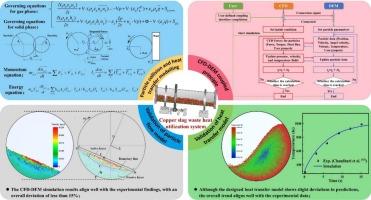废热耦合利用系统中铜渣与生物质颗粒流动及传热特性的CFD-DEM研究
IF 4.6
2区 工程技术
Q2 ENGINEERING, CHEMICAL
引用次数: 0
摘要
冶金工业作为一个高耗能行业,拥有大量未开发的余热资源,高效回收渣热已成为一个严峻的挑战。为了解决传统回收技术的局限性,本研究提出了一种将生物质热化学转化与冶金渣热回收相结合的创新方法,形成了一种新型的耦合余热利用系统。采用耦合CFD-DEM建立三维旋转反应器模型,结合致密离散相模型(DDPM),对热铜渣(CS)与生物质颗粒(WTS)之间的多相流动和传热相互作用进行数值分析。结果表明:增加CS载荷可促进颗粒混合,提高平均轧制速度,改善WTS与CS之间的热接触,从而加速传热;颗粒床表现出典型的滚动流态,有明显的主动区(近壁)和被动区(核心)。值得注意的是,20%的CS负荷产生最高和最均匀的温度分布,而即使是5%的负荷也显著改善了加热性能。颗粒轨迹分析表明,离心力和剪切力对颗粒的径向偏析影响了颗粒的导热性。在所有情况下,混合指数保持在0.2以下,表明由于颗粒大小和密度的差异,混合有限。此外,更高的转速可以改善热均匀性,8 rpm被确定为最佳转速。CS提高了气相的有效导热系数,使得温度分布更加均匀。这些发现为回转窑中的颗粒动力学和传热提供了详细的见解,提高了生物质转化效率和工业废热回收。本文章由计算机程序翻译,如有差异,请以英文原文为准。

CFD-DEM investigation of the flow and heat transfer characteristic of copper slag and biomass particles in a coupled waste heat utilization system
As a high-energy-consuming sector, the metallurgical industry possesses substantial untapped waste heat resources, with efficient recovery of slag heat emerging as a critical challenge. To address the limitations of conventional recovery technologies, this study proposes an innovative approach that integrates biomass thermochemical conversion with metallurgical slag heat recovery, resulting in a novel coupled waste heat utilization system. A three-dimensional rotary reactor model was created using a coupled CFD-DEM, incorporating the dense discrete phase model (DDPM) to numerically analyze the multiphase flow and heat transfer interactions between hot copper slag (CS) and biomass particles (WTS). The results demonstrate that increasing CS loading enhances particle mixing, elevates average rolling velocity, and improves thermal contact between WTS and CS, thereby accelerating heat transfer. The particle bed exhibits a typical rolling flow regime with distinct active (near-wall) and passive (core) zones. Notably, a 20 % CS loading produces the highest and most uniform temperature distribution, while even a 5 % loading significantly improves heating performance. Particle trajectory analysis reveals strong radial segregation driven by centrifugal and shear forces, which influences thermal conductivity. Across all cases, the mixing index remains below 0.2, indicating limited mixing due to disparities in particle size and density. Moreover, higher rotation speeds improve thermal uniformity, with 8 rpm identified as the optimal condition. CS enhances the gas phase's effective thermal conductivity, leading to a more uniform temperature distribution. These findings provide detailed insights into particle dynamics and heat transfer in rotary kilns, enhancing biomass conversion efficiency and industrial waste heat recovery.
求助全文
通过发布文献求助,成功后即可免费获取论文全文。
去求助
来源期刊

Powder Technology
工程技术-工程:化工
CiteScore
9.90
自引率
15.40%
发文量
1047
审稿时长
46 days
期刊介绍:
Powder Technology is an International Journal on the Science and Technology of Wet and Dry Particulate Systems. Powder Technology publishes papers on all aspects of the formation of particles and their characterisation and on the study of systems containing particulate solids. No limitation is imposed on the size of the particles, which may range from nanometre scale, as in pigments or aerosols, to that of mined or quarried materials. The following list of topics is not intended to be comprehensive, but rather to indicate typical subjects which fall within the scope of the journal's interests:
Formation and synthesis of particles by precipitation and other methods.
Modification of particles by agglomeration, coating, comminution and attrition.
Characterisation of the size, shape, surface area, pore structure and strength of particles and agglomerates (including the origins and effects of inter particle forces).
Packing, failure, flow and permeability of assemblies of particles.
Particle-particle interactions and suspension rheology.
Handling and processing operations such as slurry flow, fluidization, pneumatic conveying.
Interactions between particles and their environment, including delivery of particulate products to the body.
Applications of particle technology in production of pharmaceuticals, chemicals, foods, pigments, structural, and functional materials and in environmental and energy related matters.
For materials-oriented contributions we are looking for articles revealing the effect of particle/powder characteristics (size, morphology and composition, in that order) on material performance or functionality and, ideally, comparison to any industrial standard.
 求助内容:
求助内容: 应助结果提醒方式:
应助结果提醒方式:


